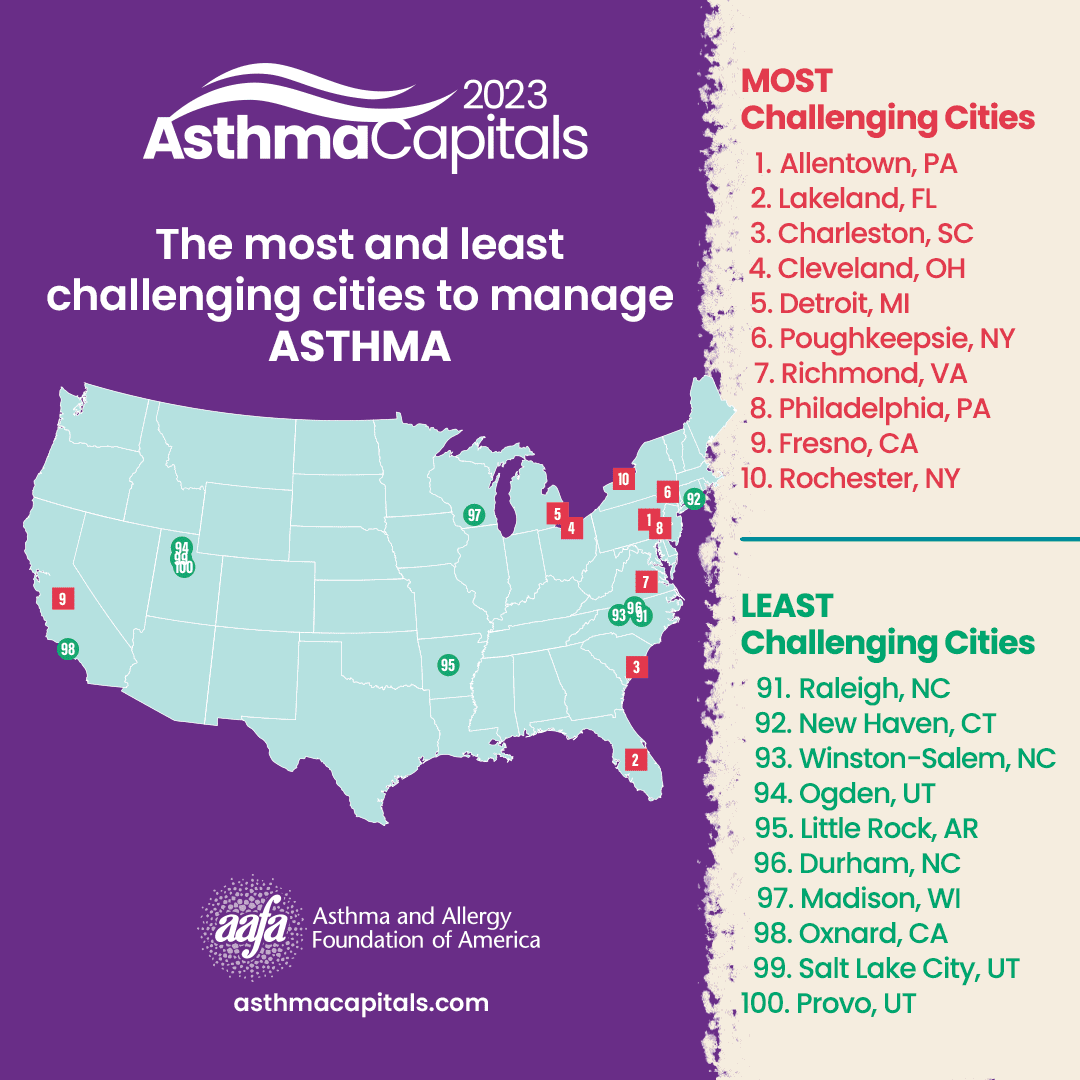News
New Report Reveals Most Challenging Cities to Live in the U.S. With Asthma
AAFA’s 2023 Asthma Capitals™ report highlights key issues impacting people with asthma and how to take action
Washington D.C., September 7, 2023 — Today, the Asthma and Allergy Foundation of America (AAFA) released its 2023 Asthma Capitals™ report, revealing the most challenging places to live with asthma. The report analyzes data from the 100 most populated cities in the continental United States to determine a city’s ranking. This year, Allentown, PA takes the top spot.
The report uses three health outcomes to establish a ranking for each city: asthma prevalence, emergency department (ED) visits for asthma, and deaths due to asthma. The report also discusses risk factors that contribute to these outcomes: poverty, air quality, access to specialist medical care, pollen allergy, medicine use, tobacco policies, and lack of health insurance.
The top 20 Asthma Capitals™ for 2023 are:
1. Allentown, PA
2. Lakeland, FL
3. Charleston, SC
4. Cleveland, OH
5. Detroit, MI
6. Poughkeepsie, NY
7. Richmond, VA
8. Philadelphia, PA
9. Fresno, CA
10. Rochester, NY
11. Columbus, OH
12. Baltimore, MD
13. St. Louis, MO
14. Orlando, FL
15. New York, NY
16. Harrisburg, PA
17. McAllen, TX
18. Omaha, NE
19. Dayton, OH
20. Greenville, SC
Allentown is the most challenging city in the U.S. to live with asthma due to its higher-than-average asthma prevalence, higher-than-average ED visits for asthma, and high deaths due to asthma. To see the complete, 100-city list ranking visit asthmacapitals.com

The Asthma Capitals report acknowledges that where a person lives can significantly impact their health. Social, economic, and environmental disadvantages play a role in determining asthma outcomes. Many of the top Asthma Capitals are also facing major challenges and inequities that lead to health disparities.
“This report highlights the major risk factors for those who have asthma,” said Kenneth Mendez, president and CEO of AAFA. “AAFA’s Asthma Capitals report offers insight into how poverty, uninsured rates, and air quality impact the quality of life for the 27 million people in the United States living with asthma. Understanding where these risk factors are hitting folks the hardest can help us develop long-term solutions.”
The month of September, also known as Asthma Peak Month, sees more asthma exacerbations and emergency department visits than any other month. The third week of the month – known as Asthma Peak Week – is often the worst. Several factors, including ragweed pollen peaking, cold and flu season starting, and children going back to school, create a perfect storm for people with asthma in the United States. But reduced asthma rates and deaths are possible. The Asthma Capitals report highlights where we can focus our efforts for healthier environments and communities.
“September is a particularly challenging time to live with asthma,” said Melanie Carver, chief mission officer at AAFA. “AAFA’s report not only outlines the conditions impacting asthma this month such as increased pollen presence and respiratory illnesses, but also points to ways to help manage asthma. Additionally, it is imperative that policymakers know that affordable and accessible health care, clean air, and economic stability are essential tools for helping people manage and control their asthma.”
For the latest AAFA news and resources go to: aafa.org
Press Contact:
Andy Spears
Public Affairs Manager
Asthma and Allergy Foundation of America (AAFA)
gro.afaa@aidem
About the Research
AAFA publishes the Asthma Capitals™ report to raise awareness about the nationwide impacts of asthma. The report analyzes data from across the continental United States and ranks the 100 largest cities where it is challenging to live with asthma. The report ranks cities by the most critical of health outcomes – asthma prevalence, emergency department visits due to asthma attacks, and asthma mortality. The outcomes are not weighted equally. The report also examines asthma risk factors that influence the outcomes. Visit asthmacapitals.com to see the full list of 100 cities, methodology, and to learn more about asthma management.
About AAFA
Founded in 1953, AAFA is the oldest and largest non-profit patient organization dedicated to saving lives and reducing the burden of disease for people with asthma, allergies and related conditions through research, education, advocacy and support. AAFA offers extensive support for individuals and families affected by asthma and allergic diseases, such as food allergies and atopic dermatitis (eczema). Through its online patient support communities, network of local chapters and affiliated support groups, AAFA empowers patients and their families by providing practical, evidence-based information and community programs and services. AAFA is the only asthma and allergy patient advocacy group that is certified to meet the standards of excellence set by the National Health Council. For more information, visit: aafa.org








